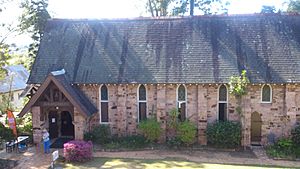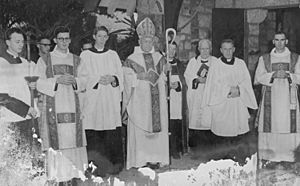Old Bishopsbourne Chapel facts for kids
Quick facts for kids Old Bishopsbourne Chapel |
|
|---|---|

Old Bishopsbourne Chapel, 2015
|
|
| Location | 233 Milton Road, Milton, City of Brisbane, Queensland, Australia |
| Design period | 1900 - 1914 (early 20th century) |
| Built | 1912 |
| Architect | Robin Dods |
| Architectural style(s) | Gothic |
| Official name: Old Bishopsbourne Chapel, St Francis' Theological College | |
| Type | state heritage (built) |
| Designated | 21 October 1992 |
| Reference no. | 600255 |
| Significant period | 1912 (fabric) |
| Significant components | pipe organ |
| Builders | Hall & Myers |
| Lua error in Module:Location_map at line 420: attempt to index field 'wikibase' (a nil value). | |
The Old Bishopsbourne Chapel is a historic church building in Milton, Brisbane, Australia. It is an Anglican chapel, which is a small place of worship. This special building was designed by a famous architect named Robin Dods. It was built in 1912 by Hall & Myers. It is also known as St Francis' Theological College Chapel. Sometimes it is called the Chapel of the Holy Spirit. This chapel is listed on the Queensland Heritage Register as an important historical site.
Contents
A Look Back in Time
The stone chapel at Old Bishopsbourne was built in 1912. It replaced an older wooden chapel that was built around 1870. The first chapel was designed by Richard George Suter.
Archbishop Donaldson arrived at Bishopsbourne in 1904. He saw that the original chapel was old and needed to be replaced.
In 1912, Archbishop Donaldson asked the architects Hall and Dods to design a new chapel. He wanted it to fit well with the existing buildings and grounds. Robin Smith Dods created the design. Builders Hall and Meyers constructed the chapel under his guidance. It was officially opened in 1912.
Robin Dods worked in Brisbane from 1896 to 1916. With this chapel, he showed how simple design can be very powerful. He was very skilled with building materials and shapes.
Since 1936, students from St Francis' Theological College have taken care of the chapel. In 1971, a new loft and a restored pipe organ were added. These were given from a church nearby.
Many Anglican schools in Queensland have chapels. However, very few are as old as St Francis' Chapel. Even fewer are built from local stone like this one.
What the Chapel Looks Like
The chapel is built from a type of stone called Brisbane tuff. It has a simple rectangular shape, about 70 feet long and 20 feet wide. When you are inside, it feels like an old medieval church. Yet, it also has a Queensland style from the early 1900s.
The walls are about 18 inches thick. They have strong supports called buttresses on the outside. These buttresses help hold up the very steep roof. The roof is covered with slate tiles. Inside, you can see the roof's wooden structure. It has six large timber trusses that support it.
The chapel gets its light from long, narrow windows. These are in the Gothic style. They are placed in the spaces between the buttresses. These windows are special because their lower parts are not made of glass. Instead, they have wooden shutters. These shutters can be opened to let in air and light.
A small porch sticks out over the main entrance. This entrance leads to a small room called a vestry. A wooden screen separates the vestry from the main entrance area.
The floor is about 6 inches above the ground. It is covered with red concrete. At the east end, the floor originally had five steps leading up to the sanctuary. The sanctuary is the holy part of the church where the altar is. One step has been removed. This allows the altar to stand freely, away from the back wall.
The chapel is simply decorated. It does not have many fancy ornaments. The sanctuary area is covered with panels of silky oak wood. The wooden altar has simple gold designs of Australian plants.
The loft at the western end of the chapel was added carefully. It fits well with the rest of the building.
Why This Place is Important
The Old Bishopsbourne Chapel was added to the Queensland Heritage Register on 21 October 1992. This means it is a very important historical site.
Its Place in History
This chapel is important because it has been linked to the Anglican Archbishops of Brisbane for over 50 years. It has also been part of the theological college since 1936.
A Rare and Special Place
The chapel is unique in Brisbane. It is rare because of its purpose, its building materials, and its location. It is a key part of the historic Old Bishopsbourne area. This area includes St Francis Theological College.
A Great Example of Architecture
The Old Bishopsbourne Chapel was built in 1912. It is known for its amazing architectural quality. It is a wonderful example of church buildings designed by Robin S Dods.
Its Beautiful Design
The chapel has great aesthetic significance. This means it is considered very beautiful. It shows a high level of creative skill from the time it was built.
Connected to a Key Person
The chapel has a special connection to Robin S Dods. He was a very important architect in Queensland's history. The chapel is a fine example of his work.


